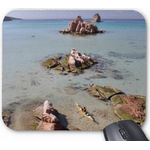Photo album:
• Album Baja 2013
Video:
• Video Baja 2013
Related links:
La Paz:
• CICESE Unidad La Paz
• Parque Nacional
Archipiélago de Espíritu
Santo
• Mar y Aventuras Outfitter
Weather and Tide forecast:
• Buoyweather
• Windfinder
• Tide forecast (CICESE)
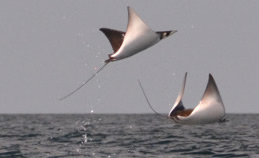 Kayaking from La Paz to Loreto
Kayaking from La Paz to Loreto
This is a 13-day activity from La Paz to Loreto.
Day 1: From El Portugués to San Francisquito Island
Day 2: From San Francisquito Island to Punta Colorado
Day 3: From Punta Colorado to the West Side
Day 4: From the West Side to the peninsula
Day 5: From the peninsula to Puerto Gato
Day 6: From Puerto Gato to Punta Ballena
Day 7: From Punta Ballena to Montserrat Island
Day 8: From Montserrat Island to Southwest of Carmen Island
Day 9: West side of Carmen Island
Day 10: East side of Carmen Island
Day 11: East & South of Carmen Island
Day 12: Danzante Island
Day 13: From Danzante Island to the peninsula
Introduction
This trip really starts at El Portugués (northern tip of the La Paz bay) and ends at Puerto Escondido (just South of Loreto). I (Cèsar) joined our good friend Toni, alias Toni de Baja (www.tonidebaja.com), for this trip which is part of his third expedition on the Sea of Cortez. Actually, before starting this trip, we spent a week around the Espíritu Santo Island in front of La Paz with Judit and some other friends. Unfortunately, Judit couldn’t join us for the following 2 weeks. You can read about our trip around the Espíritu Santo Island from a previous year here.
Paddling from El Portugués to Puerto Escondido, took us 13 days of excellent weather with only one morning stranded on the beach due to the wind. The route combines a mix of coastal paddling and island hopping for a total of 211 statute miles. Some of the crossings between islands or between the peninsula and an island are 10 miles long. Such crossings should not be underestimated, even if you are an experienced sea kayaker. Winds and sea conditions can change rapidly in the Sea of Cortez. Judit and our friends in San Diego provided us with daily weather forecast through our satellite communications. The Norte winds usually last for 3 days and can be very strong.
Keep in mind that this area is basically uninhabited. There are only a handful of spots where you can find people and it’s not guarantee that you can resupply. That brings up the main difficulty of this trip: drinking water. Toni recently had customized his kayak and designed a support for a desalinizing pump. He was able to pump with the rudder pedals while paddling. Quite an invention that improved our quality of life at the end of every day. Instead of having to spend a few hours pumping water, we had our water bags already filled with fresh water. Thanks Toni for pumping all those gallons of water for me!! Food is not as problematic since it can be packed efficiently and if you are skilled in catching fresh fish (permit required) you will have delicious meals.
Allow plenty of time for wild life spotting. Often times you will deviate from your planned route to get closer. Also, when planning routes, take into account that coasting is in reality significantly longer than it seems on the map. After all these basic but very important considerations, read on and enjoy stories about a variety of unique experiences, from wild life encounters to inner reflections and feelings.Day 1: From El Portugués to San Francisquito Island
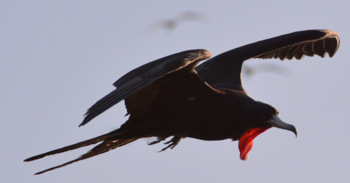
Facts:
Distance: 12.1 miles
Duration: 5:35 h.
Date: 04/22/2013
Description of the route:
The road from La Paz to El Portugués is partially paved. After that, the dirt road is in fairly good conditions except for the frequent and annoying washboard. All our gear rattles in the back of the Mar y Aventuras van. The kayaks on the roof must be suffering the bumpy ride on top of the heat. The sierra to the left of the road shows beautiful cliffs with multiple layers and colors. According to our driver Mickey, the area is mined for phosphor.
El Portugués (Km 51 of the dirt road) is just a few fishermen shacks with no services. Mickey asks for permission to launch our kayaks from their beach. He knows everybody along this route. He actually has been waving every single person or vehicle we have found along the way. We unload everything and start the 3D Tetris game to fit all the food and gear inside the kayaks. Mickey watches us with skepticism but we finally succeed. The day is totally calm and we are eager to start paddling. With very little ceremony one of the fishermen takes a picture of us and we launch.
We paddle North along the coast for 1.8 miles and then decide to start the crossing towards the San Francisquito Island. The sea is very calm and everything is quiet. Besides a few mantas jumping in the distance and a couple of sea lions sleeping with their fin up over the surface, the only exciting moment of the day is when Toni´s fishing line gets pulled very strongly. His kayak moves backwards first and then forward but after a few seconds the line loses tension. It´s gone! Whatever it was, it was very big. We almost feel thankful that it got released. When Toni checks the hook, there is still a small piece of flesh there, proving it was not a fisherman’s tale.
After the 7 miles of crossing we get to the South bay on San Francisquito. It’s busy with sail boats and pangas and since it´s still early to camp we decide to go around to catch something for diner in the South tip. Although this seems to us premium grounds for fishing, we're not lucky. We keep going around the island and finally settle in a beach on the northern tip, close to an old light house. There are some seagulls nesting at the end of the beach and they welcome us by flying low over our heads and bombarding us with poop. Eventually they get used to us and let us stay.

After setting up camp we climb to a near hill and enjoy the sunset from there. In the sunset light, the golden grass, the dark blue of the sea, the San José Island and the blue sky form a beautiful picture. On our way back to camp we pass near the tiny mangrove below the light house. Our friends, the seagulls squeal at us again but we are too hungry to pay attention to them. Even if we didn´t catch any fish today, diner tastes good and the final tequila sip makes us lay back and contemplate the moon and the stars from the pebble beach. Don't get me wrong, we have a single bottle for both for 13 days, so it was a small sip.
Day 2: From San Francisquito Island to Punta Colorado
Facts:
Distance: 18.5 miles
Duration: 8:30 h.
Date: 04/23/2013
Description of the route:
Our first stop is at the El Pardito Island, just a mile from our camp. Actually, the official name is Coyote Island but everybody refers to it as El Pardito. This tiny island hosts the Cuevas family. The grandfather of Mr. Cuevas established here to escape from the outlaw people living in the peninsula. He didn’t want the risks of a dangerous life for his wife and children and settled in a fishermen camp in the only flat area of the island. It’s just big enough for the pangas his descendants use today and a couple more small houses. The other few buildings are built on man-made terraces on the slopes of the small central island hill. There are around 8 constructions including the Whale Museum of the Isla Pardito and a humble chapel. The museum is outdoors and consists of a collection of whale bones scattered around. It stands out a huge whale jaw from a blue whale and a whale spine reconstruction probably using vertebras from different specimens.
Two of the young people are busy with the morning catch. On one net they caught 6 jureles and 3 cazones, on the low side compared to the previous days. On the smaller net, they caught Cardenales, Piernas and several other species. On the second panga, Mr. Cuevas and an older person untangle the jureles from their net. One of them has been almost completely devoured by the sea lions. Mr. Cuevas explains that the sea lions learn fast about their fishing schedule, preferred spots and even recognize their pangas. He is not mad at them though. He acknowledges that they need to feed and that the strangled jureles in the nets are an easy prey. In the sand, upside down, lays a couple of centollos, a crab species similar to the king crab. The jureles are about 3 feet long and we are thinking that the monster that bit Toni’s hook yesterday was one of them. Mr. Cuevas talks about the stories his grandfather told his father. How the business of the shark liver was so lucrative for vitamins and even weapons fabrication. He explains us the different species they catch and the various techniques they use depending on the season. He is very proud of the 5 generations living here since his grandfather.
We leave El Pardito and circle around the rocks in front of the island. Toni catches the first pargo of the day, a pretty good size one. Then we cross to the long sand bar of San José. At the end of the sand bar (3.4 miles from the beginning), is the South entrance to the San José mangroves. The tide is going out and makes for a rough paddle in the lagoon due to the waves the current forms on the very shallow passage. Inside, the water is calm and we tour a few mangrove channels and islands but we still have a long way today so we exit the lagoon towards the South tip of San José.
 At mile 8.6 we turn around the South tip and start paddling along the East side of the island. We pass the Stonehead beach, named after the big outcrop. Very low activity for the rest of the day, except for the cabrilla Toni catches and the pargo I get. We release both since they would be more that we can eat tonight after the first pargo.
At mile 8.6 we turn around the South tip and start paddling along the East side of the island. We pass the Stonehead beach, named after the big outcrop. Very low activity for the rest of the day, except for the cabrilla Toni catches and the pargo I get. We release both since they would be more that we can eat tonight after the first pargo.
We decide to camp half a mile before Punta Colorado on a superb beach backed by yellow rounded sandstone formations. After setting camp we go for a hike and exploring the fossils on the stratified walls, Toni founds a remarkably well conserved prehistoric shark tooth. The tooth is about 2 inches long and we fantasize about the size of this whale‑eater monster.
We finish our day having some fish tacos with the pargo, fried on a pan with onion, jalapeños seasoned with lime and soy sauce. A well-deserved tasty dinner after an 18.5 mile day.
Day 3: From Punta Colorado to West Side of San José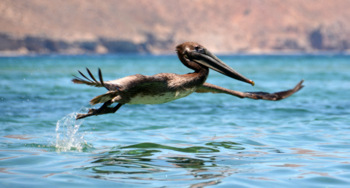
Facts:
Distance: 16.6 miles
Duration: 8:45 h.
Date: 04/24/2013
Description of the route:
With the morning light, the ochre sandstone formation behind the tents makes our camp setting look charming. Once on the water, just around the first corner, the Punta Colorado shows its beauty. High cliffs with different hues of pink and red contrast with the green and blue water. Although the sea is choppy, we go several times around to fully enjoy it.
At 1.5 miles from camp, we land on a beach with a natural arch. Short after that, Toni catches the first fish of the day, a cornet fish. We keep paddling North and along the way we arrive in time for the 1 o’clock pelican show. Right next to the shore there is a school of sardines and a flock of pelicans are feasting on them. They hover over them and dart into the water with acrobatic last minute pirouettes. A passing by panga from the close by ranch takes advantage of the opportunity and stops to catch some sardines probably for bait. Of course, that´s the end of the show. A few minutes after resuming paddling, I reel in a pretty good size pargo but it cuts the line in the last moment and gets away.

At mile 8.1, we pass in front of the ranch. The wind has been blowing from the East with increasing force and the last couple of miles before the North tip are rough so we hurry up to go around it looking for calmer waters. It’s totally flat on the West side, as expected. We land in the first beach to rest and have some tortillas with Nutella. A well-deserved treat! By now Toni has caught and released 3 more fish, a small cabrilla and 2 hueso verdes (no good for eating). I keep trying and failing or losing my lure tangled in the rocks. After lunch, we move again and Toni catches yet another fish. We are keeping this one. It’s a delicious barracuda. I finally catch one but we have enough food for tonight and this one is too bony anyway.
We are tired and start looking for a beach to camp. The Fig Tree beach is fairly unattractive and we decide to go for the next one, the Sola Palm beach. Before that, at mile 16, we pass a beautiful spot where the mountains show a multitude of colors similar to the Death Valley Artist’s Palette. The wind has changed direction and is now blowing from the South making us paddle hard so we don’t stop here to explore the area. We’ll hike back after setting camp. There is no sandy spot in front of the lonely palm so we go for a half a mile more. In that short stretch we spot 2 vultures feeding on a carcass on the beach but we don’t pay much attention. That’s exactly what vultures do. We finally land and set up the tents.
Right behind the tents there is a dry stream and we decide to explore it. It’s surprising how abundant the vegetation is here: not only cacti but also trees and shrubs. The sun is already low and we hurry to the Artist’s Palette. We first go back to camp to check on our dinner and follow the beach North. We are about to find out that the carcass the vultures were feeding on was a big sea lion. Before identifying it we can smell the rotten stink from yards away. We realize that if the wind changes, the smell is going to reach our camp and will be unbearable. We get 10 minutes late to the Artist’s Palette and miss the last rays of Sun on it but the mix of purples, browns and greys is still beautiful. On our way back to camp, a rattle snake warns us and I’m only able to jump away and see how it slithers backwards under a bush.
Every time it’s my turn to clean the catch of the day, I promise to myself not to fish anymore. At least the cornet fish and the barracuda are not only easier to clean but also delicious. Fried garlic and onion with a touch of soy sauce. We don’t even care for rice or tortillas. There is plenty of fish for both. Even for the couple of mice that look at us hungry from under my kayak. They are not shy and the next time we look, one is on top of the plate we have used to cut the condiments. It’s time to relax and enjoy the tequila but suddenly we can smell the repugnant stink from our dead neighbor. The breeze is now coming from the North and we decide to bury it before going to bed. It’s almost 11 o’clock and here we go with a couple of half-paddles to cover the carcass with rocks and sand under a full moon. Idyllic.
Today, again, there has been almost no wild life activity on the water. Tomorrow we cross back to the peninsula hoping to see more.
Day 4: From the West Side to the peninsula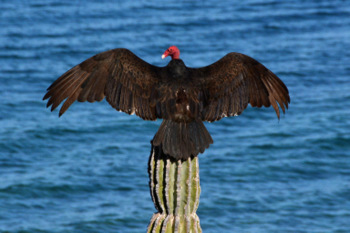
Facts:
Distance: 14.3 miles
Duration: 7:45 h.
Date: 04/25/2013
Description of the route:
Well, well, well. Our good attitude towards the marine mammals last night has paid off today. We were crossing back to the peninsula and half way there we stop for a snack. About 25 yards away I see a fin that resembles a dolphin but bigger and unlike the dolphins is alone. It’s not a dolphin. It’s a Minke whale. Initially we paddle hard to keep up with him but soon we realize that there is something strange. It surfaces to breathe in places he’s not supposed to be. Maybe it’s a pod and not a loner. Soon we realize he is checking on us. When he passes below our kayaks showing his white pectoral fins we are positive that we don’t need to paddle to catch up. He is playing with us.
The display goes on and on and every time he pops up closer to our kayaks. As close as 10 feet. And then we see a second one. We can’t believe it. We are just drifting and at least a couple of whales keep passing by under us and popping up so close we can see the blowholes. It’s easy to predict where they will emerge because of their white fins and belly. Often times they pass under us before coming out to breathe or rather to watch us. The wind has died out completely and we are now having lunch on board very relaxed while the whales keep showing off. At some point, I jump into the water with my underwater camera but the visibility is reduced. I still can see the white fins passing by and then the big tale. What a display! After almost 3 hours and 3.6 miles drifting they get tired of us and leave. We couldn’t have asked for more. We have had plenty of time to photograph, observe and even swim with them.
Short after they leave and while we are still excitedly talking about what just happened, we spot a pod of dolphins jumping out of the water. We set on a trajectory to intercept them and paddle as fast as we can. We get very close but they swim fast and we cannot keep up with them. But they turn around and return, maybe on their daily fishing pattern.
The last highlight of the day is the bird colony on La Habana Island. Pelicans, frigatebirds, brown and blue footed boobies have covered this rock with guano. We can see some of the bobbies’ eggs clinging on small ledges on the cliff. After two loops around the island, we paddle to the coast and look for a camp. Toni catches a cabrilla for dinner (as usual provider of the catch of the day) and we head to the closest bay. The water is so calm that it hurts to disturb its glassy surface. We paddle with care, without splashes, in silence, reviving our encounter with the minkies.
Once we set foot on the beach we celebrate the day with a Baja screwdriver: orange flavored Gatorade with Tequila. As the sun sets, the seagulls surround me while I clean the cabrilla and Toni prepares the rest of the dinner. We are just starting to enjoy it when the full moon rises over the skyline of the San José Island. It’s an big orange round brilliant moon that reflects its light on a peaceful Sea of Cortés. This is Baja!
Day 5: From the peninsula to Puerto Gato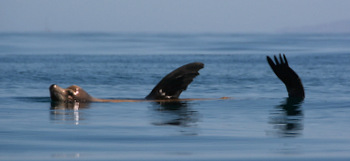
Facts:
Distance: 18.4 miles
Duration: 9:30 h.
Date: 04/26/2013
Description of the route:
Today is my lucky day. In total I catch four fish but released 2 trigger fish since they are very hard to clean. The cornet fish and of course the sea bass, we are keeping them. Today we follow the coast closely to appreciate the color of the rock formations. The stretch before Punta del Cobre is particularly beautiful.
In the afternoon we see two pods of dolphins exhibiting a curious behavior. After jumping out of the water, they flap their tail repeatedly against the water to make loud sounds. However, the highlight of the day is yet to come. We keep paddling and Toni yells: “a whale spout”. He is pointing far to the horizon and after a couple of seconds I see a second spout. There are at least 3 whales moving South. We paddle full stroke to intercept them. They have dived and we have no clue when the will emerge again. After 30 minutes of paddling hard we stop to rest and listen. And that’s when one of them breaches almost its full body out of the water showing its belly and falls on its back with a loud thumping sound. Unfortunately, Toni only sees the huge splash. We paddle again but they swim fast. We get so see one of them whipping its tail in the air and then flapping it against the water surface. I’m still in awe how that humongous animal can jump out of the water.
Our next goal is a lagoon just past Timbabichi (one of few inhabited places) but the tide is too low and we cannot paddle in. We explore the area briefly on foot and find it very interesting. Worth exploring it some other time.
We keep going till Puerto Gato where we start our routine of setting up camp, cleaning the catch and prepare dinner.
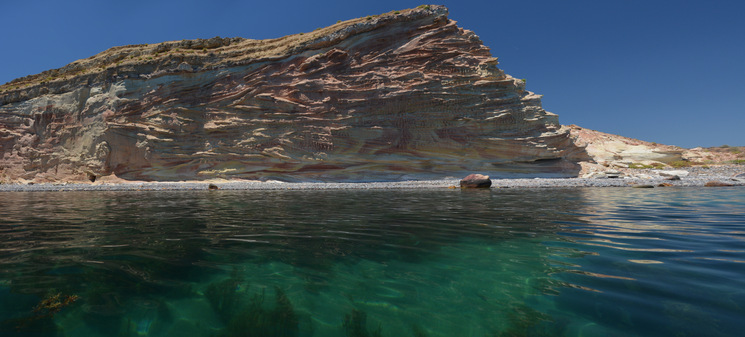
Day 6: From Puerto Gato to Punta Ballena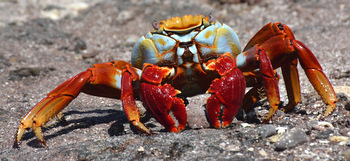
Facts:
Distance: 16.4 miles
Duration: 7:00 h.
Date: 04/27/2013
Description of the route:
The day starts with a beautiful sunrise that wakes me up at 7am. Seagulls, a vulture and a crow fight over the remains of yesterday’s catch. What a show! Three of the nicest birds friendly sharing a meal.
When we are almost ready to launch, Manuel shows up on his panga. Toni knows him from his previous trips. His skin is carved by the sun and the sea and his hands feel like sandpaper. He is a local and knows everybody in the area. We chat with him for a while and Toni interviews him about the “Vagabundos del Mar”. Manuel gives him a couple of interesting data points. He also sells us a couple of lobsters he just caught and will serve us as a gourmet lunch later.
We paddle out of the bay and then go North, parallel to the coast at about 2 miles from it, hoping to find the humpbacks we saw yesterday. Instead we see a very different and strange thing. Initially only I see it: a dark creature jumping off the water and falling quite clumsy. It’s not very close but clearly it’s not a mammal. It has a dorsal fin but the tail is vertical. Actually, the upper tail is considerably longer than the bottom part. It only lasted a split second and while I describe it to Toni, it does it again. We both agree: it’s a shark. We wait with mixed feelings. Wishing to see it again jumping but hoping it’s gone. And it’s gone.
After that exciting event, we cross several pods of dolphins, some of them at least 100 strong. El Norte is picking up and we head to the coast to prepare our lobsters with quesadillas. It takes us a while to get there and the sea becomes choppy. In between waves I see a dorsal fin and a tail tip just popping out of the water. The creature is heading towards me and I can identify it as a hammerhead shark. Today appears to be shark day.
We finally reach the shore and prepare an exquisite lunch. We take it easy afterwards. Just relax in a cliff shade and watch the sea becoming calmer. We finally continue our paddling North with the same plan as this morning: get away from the coast scouting for whales. However, the result is the same as this morning. We find again our jumping shark. It shows off 2 more times and then disappears. There is something strange this evening. Flocks of birds congregate in certain spots in a frenzy dinner. Boobies and pelicans dive for fish while frigates and seagulls try to steal from them. The jumping shark notices is not the star anymore and shows up again. Toni spots his dorsal fin really close to him and after a couple of minutes, it jumps again. And now it’s gone forever.
The sun set about 30 minutes ago. The wind died out totally but there are still considerable waves although very smooth. We paddle toward Punta Ballena on a dark dense water that feels like oil with the thought of the jumping shark luring from under. The small cove next to Punta Ballena is surrounded by high cliffs and very dark. As soon as we land we look for our headlamps and set up camp. A couple of mice accompany us for dinner. No fish tonight. We didn’t even throw the lines today since we had the lobsters for lunch.
After dinner, when I get close to the shore to brush my teeth, I see little green sparks on the pebbles when the tiny waves break. I realize that tonight there is bio-luminescence. I run to put my swimming suit on and jump into my kayak. The feeling is absolutely amazing. Every paddle stroke lights up in a flash of green light. The waves formed by the tip of the kayak are green too. Fish dart away from me leaving a brilliant green trace behind them like wanting to be followed. I find myself paddling in circles in the dark, enjoying being a floating firefly. When I’m thinking about going back to shore I see a strange orange spot in the horizon. It takes me a couple of seconds to realize it’s the moon! But orange, very orange! I start paddling under the stars, over green sparks towards an orange moon. And I notice a big smile on my face. No, I’m not watching Avatar. I’m experiencing Baja.
Day 7: From Punta Ballena to Montserrat Island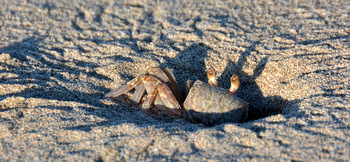
Facts:
Distance: 19.8 miles
Duration: 10:00 h.
Date: 04/28/2013
Description of the route:
Today has been a long day but with little excitement. Our initial plan was to cross to Montserrat Island tomorrow but when we got to Punta Marcial (3.2 miles from the camp) and saw the sea conditions, we decided to take advantage and do it today. Going around the frightening Punta Marcial was a piece of cake today. On a windy day and if the current is strong, this tip is dangerous even for experience kayakers. There is something in the submarine orography that creates big waves.
During the crossing (about 9.5 miles) we have experienced the turbulences and waves currents and land tips generate. When leaving the peninsula and also when approaching the island, the conditions became not so comfortable as the rest of the crossing. We didn’t see any interesting wild life except for a pod of dolphins. However, about 0.5 miles from Montserrat, Toni catches a tuna that makes the perfect excuse to stop for lunch. Supreme fresh wild caught tuna with rice and tomato sauce. The best treat so far.
After some rest and a short exploration on foot we continue paddling to the North end of the island in a counter clock direction. Only a few mantas jumping but very quiet otherwise. We finally get to our camp, in an area where some ochre short cliffs have fossils. We explore the terrain and can see millions of shells but no giant shark teeth. It’s been a long day and we both are tired so we go to bed early.
Day 8: From Montserrat Island to SW of Carmen Island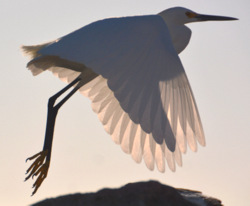
Facts:
Distance: 20.2 miles
Duration: 8:15 h.
Date: 04/29/2013
Description of the route:
The plan for today was to cross back to the peninsula but in the end, since the weather was so great, we decided to go for a longer crossing and paddle directly to the Carmen Island. The crossing is about 11 miles but a couple of whale encounters deviated us from the straight line. The first one happened after 3 miles. A pod of 3 whales passed in front of us at some distance and we chased them guessing their traveling direction. The first time they came back to the surface to breathe where we were expecting them but the second time they had turned left 90 degrees. They approached a spot where the pelicans were in a frenzy feeding probably on a ball of fish. The whales checked it out and continued South like nothing had happened. But one of them came up right in front of my kayak, and I could see very clearly every single vertebra between the dorsal fin and the tale as well as the hump.
We stayed with the pelicans watching them doing acrobatics in the air before plunging into the water. This time we were so close we could see the fish shaking inside the pelicans pouch before they swallowed them. Some opportunistic seagulls were harassing them to get some free meal without much success.
About half of the way to Carmen we spotted a big pod of dolphins. We changed direction to intercept them but gave up after some minutes of energetic paddling. They are fast!
When we were getting close to the southern tip of Carmen, we saw a static shiny point floating in the distance, in front of Danzante Island. I couldn’t come up with what it could be and stopped looking. A couple of minutes later, Toni saw the shiny point was breathing! We paddled towards it and found out what seemed to us a sleeping whale. He was faintly breathing once a minute approximately. When we got very very close, we waked him up. Toni, who was closer than me, still remembers with a mix of excitement and fear how the giant loudly expelled the air from his lungs before showing the fluke and dive.
We continued on the West side of Carmen. The forecast predicts a Norte in 3 days so we thought of going North on the West side and come back South on the East one where we would be shielded by the island. We passed by the Gorilla rock and released 3 fish due to having too many bones or being too small. All in all, another good day in Baja.
Day 9: West side of Carmen Island 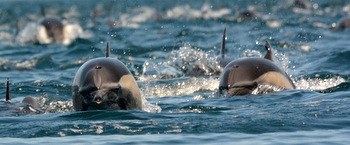
Facts:
Distance: 19.4 miles
Duration: 10:40 h.
Date: 04/30/2013
Description of the route:
The day starts slow. The water is super calm, no wind at all. But the activity accelerates after the first 5 miles. First is a tremble in the distance and tiny splashes in the horizon. We don’t know if it’s a school of jumping mantas or a pack of dolphins. Whatever it is, it’s coming fast. The tremble becomes a rumble and the splashes get bigger. Now we can see the dolphins graciously jumping as opposed to the clumsy mantas. They turn away from us so we have to paddle briskly to intercept them. This pod is huge, at least 1000 strong. When they reached our position, we were surrounded by dolphins marching full speed. We can even hear the high pitch sounds they make to communicate among them. The water is not calm anymore. It’s actually choppy. It’s an overwhelming feeling to hear the exhalations and splashing all around us. They are far away now and we have no chance to keep up with them. They go around and here they come again. Same rumble approaching. The sea has not had time to calm down. A few jump here and there but the vast majority just come out to breathe and keep moving. This repeats agian and they keep us entertained for 45 minutes. Then they finally leave. We try to catch up with them but quickly they put distance between us. We will hear them for a couple more hours but they don’t come back close anymore.
We resume paddling North and about an hour later a whale shows up from nowhere, 50 yards from us. It’s a whale, but not a humpback. It’s bigger (about 40 feet) and doesn’t have the hump in front of the dorsal fin It seems a fin whale. Paddle, paddle, paddle. Well, it is not necessary. This one is also very interested in us. We figure out we don’t need to chase him. It’s circling around us. We realize the closer we stay together, the closer to us he comes out. This one is not as predictive as the Minkes, since he doesn’t have white patches and he doesn’t go under us. But he leaves a trace of disturbances on the surface when he is close to it. We can see he is definitely circling around us. This goes on for half an hour until a sailboat passes close by and he decides the boat is more its size and leaves us for the boat.
It’s 2:30 and with all the excitement, besides some munchies, we haven’t eaten much. So we decide to cast our fishing lines to catch lunch. Incredibly, in 15 minutes we have caught 3 small jureles (a type of tuna). We stop at an almost perfectly round cove and prepare them with sautéed onion and some drops of lime juice and soy sauce. No side dish. By the time we finish eating, an eel has smelled the blood of the jureles and is sneaking around the spot where we cleaned them.
The rest of the afternoon is quiet and we take advantage of it to make some progress. We paddle until dark and finding the beach we plan to camp on becomes a challenge. We have to rely on our GPS.
Our friends in charge of sending us the wind forecast are agreeing. We will have a Norte starting on Thursday. Our plan is to move to the East side of the island to get some shelter. Hopefully we don't get stranded. I have a plane to catch.
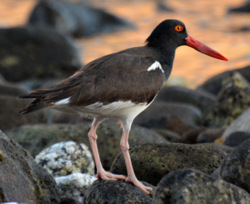 Day 10: East side of Carmen Island
Day 10: East side of Carmen Island
Facts:
Distance: 25.3 miles
Duration: 11:25 h.
Date: 05/1/2013
Description of the route:
Not much to report today. It’s been the longest day and the driest one in terms of wild life. The only new specimen we have seen it’s a glimpse of the dorsal fin of a marlin. Other than that, a couple of small dolphin pods and sea lions at Punta Lobos and Punta Perico.
We have had swell all day but very gentle for the most part, except at the exposed tips of the Northeast and right before the entrance to the Arroyo Blanco cove where we are spending the night. In this last stretch, the waves coming from the East bounce back from the cliffs and create a random wave interference that makes you shake on all 3 angles at the same time. The last forecast sent by our friends confirms that tomorrow we’ll have very strong winds from the North so most likely we will stay put in this cove which is very well protected from the North.
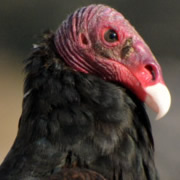 Day 11: East & South of Carmen Island
Day 11: East & South of Carmen Island
Facts:
Distance: 8.7 miles
Duration: 3:25 h.
Date: 05/02/2013
Description of the route:
I wake up with the first light. The sun has not risen yet but I feel totally awake and decide to climb the North cliff of the Arroyo Blanco cove to see the sunrise from there. The white strata forming the walls of the cove is completely filled with fossil shells. I spend some time looking for a second giant shark tooth but without luck. I sit next to the bluff edge and watch the orange sun rise from the ocean. Life in the Sea of Cortez wakes up. Flocks of pelicans fly by in formation, seagulls start their noisy day and vultures look for the thermals to climb high up from where they see everything.
As forecast, the wind is stronger than any other day. In our cove it blows from the West but that makes sense since that’s the orientation of the canyon. From my vantage point I can see white caps moving South. I head back to the beach and see that Toni is still sleeping. On the cliff on the other side of the cove 3 vultures stand with their wings open showing their backs to the sun probably to dry off the night condensation from their feathers. I approach then pretending I can go undetected but knowing that they have spotted me long time ago. However, step by step I can get pretty close to one of them, about 30 feet, and take some pictures. Toni is still in his tent and I go explore the canyon of the Arroyo Blanco. This is prime terrain for rattle snakes or so it seems to me, so I don’t go too far alone.
I’m hungry so I wake up Toni and we discuss our plan while having breakfast. We are staying. We hike the canyon choosing the widest and cleaner path to avoid cracks and bushes but as we go deeper, the canyon becomes narrower and the vegetation denser. We climb to the top of the white strata but he feels like me about the snakes and we go back to the safety of the beach. The sun is already high and we take refuge under some overhanging bluffs. We spend the afternoon reading, napping, playing with the hermit crabs…
After a couple hours, it seems the wind is dying out and we decide to move. If it looks good when we get out there, we will go to the South tip. Otherwise, we will stop at the next protected beach, less than a mile away. Of course, as soon as we have packed, the wind picks up again. The wind gusts are strong and the white caps are more abundant than we thought so we decide to stop at the San Francisco Bay. When we get there, we realize it’s a very unattractive beach. The wind shelter is in part a wall of rocks somebody built. We check the rest of the beach and don’t find a nice place. The wind is weaker now and we take our chances and paddle for the South tip. The last mile before the tip is quite choppy. That’s where a good size cabrilla bites my hook and I reel in dinner. We paddle the last 1.5 miles against the wind but it’s a short stretch.
The beach where we camp is pretty and has excellent views. We spend some time around exploring. A seagull squawks at us to protect her eggs. The last excitement of the day happens when Toni finishes cleaning the cabrilla. Two eels show up, attracted by the smell. We place the remains on a rock that forms an angle into the water. The waves are very small here and barely touch the fish which is secured by a heavy stone on top of the tail. The crabs are already feasting but it won’t last long. One of the eels has finally detected where the juicy smell comes from and slithers out of the water, crawls up the rock, bites the fish and takes it back to the water. Amazing! The crabs are still wondering what happened with their dinner.
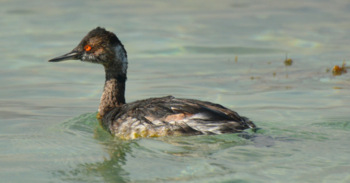 Day 12: Danzante Island
Day 12: Danzante Island
Facts:
Distance: 18.4 miles
Duration: 9:00 h.
Date: 05/03/2013
Description of the route:
It’s been a dull day. I guess we are getting spoiled. We did cross with a couple of small pods of dolphins but that has become the norm and unfortunately does not thrill us as much as the first days. We didn’t even catch any edible fish for lunch. We caught a “green bone” but as usual we released it. Once we caught one on another trip and had parasites. It seems this particular species is prone to parasites. The channel between Carmen and Danzante was choppy but not too bad. However, when we approached the North tip of Danzante, the wind picked up and white caps appeared everywhere. We still ventured into the middle of the channel between Danzante and the peninsula looking for potential whales, but the wind increased its intensity and we paddled to the Honeymoon cove for shelter and lunch.
The most exciting event today was finding a piece of art at the beach we stopped for lunch. It was a model of a Spanish 16th century caravel. It was made with half elongated water melon as a hull. The deck contour was serrated for more decoration and it even had circular holes on both sides of the hull simulating the canons. The 3 masts and yards were made of chopsticks. All of them were intricately tied using a red thread representing the rigging. The part I thought was the most creative was the sails: onion layers. Two or three per mast being the top ones smaller. The white onion sails, the red deck and the green hull made a colorful veggie caravel. Some additional details were the rudder and some flags made of apple peelings. We found it ashore so we thought it got there drifting. We put it on the water but it couldn’t stay afloat, it was rolling over. I thought that should be remediated and engaged in a restoring project. I added some extra flotation under the hull using palm branches tied together with fishing line and the most necessary improvement: the keel. This deviated from the original design since the caravels didn’t have keel but in this model it was going to be the only way to keep it afloat. The keel consisted on a piece of cane with a rock tied to the bottom end and the other inserted at the bottom of the hull. And… it sails!! We send it against the waves and wind and keeps floating but it soon turns around and sails back to shore with determination. It’s like it had found the promised Indias…
That was the fun part of the day. Then Toni realized he didn’t have his sandals with him and that he probably forgot them on our last night’s camp. Although the channel is still choppy, we paddle back to Carmen to look for them and there they were. We renamed that beach as The beach where Toni lost his sandals (which is a joke in Spanish and difficult to translate). We paddle back to Danzante but this time around the South tip. Its West coast was illuminated by a low sun that made the rock and vegetation colors spectacular. The original plan was to cross to Puerto Escondido today but I thought it’s going to be noisy with boat traffic and too close to civilization. I changed my mind and we went back to the Honeymoon cove for the last night of this incredible trip.
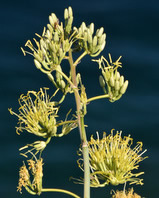 Day 13: From Danzante to the peninsula
Day 13: From Danzante to the peninsula
Facts:
Distance: 3.4 miles
Duration: 1:10 h.
Date: 05/04/2013
Description of the route:
My last day is a short one, just the crossing from Danzante to the El Quemado beach, the first beach South of Puerto Escondido. This beach doesn’t have anything special (it’s actually pretty dirty) but you don’t have to pay a fee to land. Yesterday, we arranged a transport calling from the top of the island. Yes, there is cell coverage here. As you can see, we are back to civilization. The rest of the day is dedicated to take the first shower in 13 days and prepare my return back to San Diego. Toni will rest for a few days in Loreto and continue on North.
For me the highlights of the trip have been all the close encounters with the whales and dolphins but the rest of the wildlife has been very exciting as well. The school of mantas jumping, the jumping sharks, turtles, eels, the great variety of sea birds… All the action we haven’t been able to capture with the cameras, all the feelings that cannot be expressed with words. The sensation of self-sufficiency and the value of a good friendship. All that can only surface on a special state of mind on a special place and circumstances. That’s why we keep going back to Baja.
As I write this last day of the diary, that magic night comes back to my memory. That starry sky with the bioluminescence on the water and the orange full moon raising will last in my memory forever.


